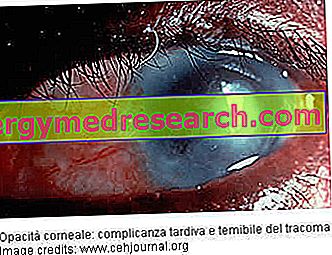Watch the video
X Watch the video on youtubeGenerality
Tired eyes are an annoying eye disorder, which usually arises when a demanding and prolonged use of sight is made.

Typical manifestations are ocular pain and itching, dry eye (or alternatively teary eye), vision problems, headache, neck pain, etc.
From the clinical point of view, tired eyes do not represent a serious disorder, however, in some circumstances, they can become so annoying as to require certain precautions to prevent their occurrence.
What are tired eyes?
Tired eyes represent an eye disorder, usually due to activities that require a demanding use of sight.
Although they are considered a minor clinical problem, tired eyes cause an annoying and sometimes very annoying feeling.
Causes
Tired eye disorder is usually related to one or more of the following causes:
- Prolonged use of computers or similar electronic devices
- Intense and continuous reading for a large number of hours
- Driving a vehicle for many consecutive hours
- Exposure to bright or dazzling lights
- Effort of sight in poorly lit environments
Among the various causes listed, in recent years the prolonged use of the computer has assumed a considerable importance; the ocular disorder resulting from it, in fact, has also been classified as a real syndrome, known as the computer vision syndrome .
RISK FACTORS
All those activities that require a very intense use of the eyes, but also vision disorders (myopia) and eye muscles, stress, fatigue, dry environments and air conditioning encourage the appearance of tired eyes.
Symptoms and Complications
Tired eyes cause:
- Sense of pain, tiredness, burning and / or itchy eyes
- Eyes that tear ( epiphora )
- Dry eyes
- Blurred vision or double vision
- Greater sensitivity to light
- Difficulty in focusing the vision
In addition, these symptoms may be accompanied by other problems that are not exactly ocular, such as: headache, neck pain, back pain and shoulder pain.
WHEN TO REFER TO THE DOCTOR

The symptoms to keep under control:
- Double vision
- Obvious changes in vision
- Lasting eye pain
- Headache
Tired eyes are usually a temporary condition . However, if the sufferer does not benefit from rest, it is often subject to the disorder or note that the symptoms get worse from time to time, it is good to require a consultation with a specialist doctor.
COMPLICATIONS
Tired eyes are not a particularly serious disorder; however, in some situations, they can be so annoying and annoying as to make sufferers unable to concentrate properly.
Lack of concentration, especially among people engaged in particular activities (such as driving), could have unpleasant consequences.
Diagnosis
Those who, worried by tired eyes, require an eye examination, are subjected to a series of eye checks and a short questionnaire about the work they do, the environments they attend, etc.
Eyesight checks are necessary for the doctor to clarify the presence or absence of an eye condition capable of predisposing to eye strain; the short questionnaire, on the other hand, serves to identify the causes or situations that favored the appearance of tired eyes.
Therefore, the diagnosis is quite rapid and does not require any particular clinical examination.
NB: as previously stated, it is advisable to request a specialist consultation only when the symptoms are persistent and worrying. In most cases, in fact, the disturbance of tired eyes is transient.
Treatment
For those who suffer sporadically from tired eyes, rest is enough; to those who, however, are subject to it in a chronic way, can serve:
- Change working conditions, improving the work position and taking breaks.
- Improve the environment where you spend most of your time, using a humidifier and avoiding smoking.
- Treat eye diseases, if they are present.
- Wear safety glasses . They must be prescribed by the ophthalmologist and should only be used during tiring eyes activities.
- Practice, on illustration of the medical specialist, particular exercises for the eyesight, which improve focus.
SOME SUGGESTIONS TO WORK IN THE LIFE OF EVERY DAY
For the reader . Anyone who reads, in order not to tire his eyes too much, must have a sufficiently powerful light, place it in front of him and project it towards the pages of the book or newspaper he is consulting.
For those who perform tasks or hobbies that require close contact (for example modeling) . The light used must be powerful and must be oriented directly towards the objects on which one is working.
For those who watch television . In the evening, it is wrong to watch television in the dark. In fact, the dark contrast of the TV room-light strains the eyes too much. Therefore, it is good practice to keep a light on (it is fine too).
TIPS FOR THOSE WHO WORK MANY HOURS AT THE COMPUTER
Since the tired eyes from prolonged use of the computer are, today, a very frequent disorder, below are two simple guides : one on how to improve the working position and another on the most effective preventive measures .
Tired Eyes and Computer
What the computer workstation should be
The correct position . The user must position the screen in front of him, at a minimum distance of 50 centimeters, and not higher than his eyes (therefore, the view must always be directed downwards). If bifocal lenses are worn, the position of the screen should allow the glasses being used to be used correctly; therefore, if you need to lower the screen further, it is important to do so.
The surrounding light . To understand if the lighting in the room is correct or not, you need to look at the screen with the computer turned off. If you notice the reflections of the lamps in the room or other objects located behind the observer on it, you need to correct the position of the computer.
Any light located above or behind the user is wrong.
The monitor . It is incorrect to position the screen in front of a window or a white wall. Moreover, it is equally incorrect that there is a light source nearby, as the light emitted by it creates an annoying reflection and, in the long run, counterproductive.
The brightness and contrast function of the monitor should be adjusted in the most appropriate and comfortable manner.
Keep the screen clean . The screen should be cleaned periodically, because dirt and dust create minimal reflections that strain the eyes.
Keyboard position . The correct position of the keyboard is approximately at the height of the elbows. If it is located too high or too low, those who use the computer assume incorrect postures that strain their eyes and cause the wrists and neck to bend abnormally.
Position of documents and texts that are consulted during work activities . Written documents, which you may need during work, must be placed near the monitor, at a readable distance. By doing so, the eye is less engaged in focus and gets tired later.
Prevention of tired eyes from prolonged use of the computer
Give short breaks to the eyes. It is important to look away from the screen every 15-30 minutes and take a short break, perhaps looking away. Furthermore, it is equally useful, at least once every hour, to stand up and take a few steps. Finally, if possible, it is good to close your eyes from time to time for a few moments.
Remember to blink frequently. Beating the eyelids often moistens and refreshes the eye, preventing dryness. Those who spend many hours on the computer for work tend to forget to blink, in fact they often suffer from dry eye.

Improve the quality of the environment in which you work. It is good practice to equip the room where you are working with a humidifier, so that the air does not dry out too much, and do not smoke.
Massage the eyes twice a day. The critical points to be gently massaged with the fingers and the palm of the hand are: the upper part and the lower part of the eyelids, the orbits, the temples and the cheekbones. Eyelid massage stimulates tearing, while orbital massage and other areas mentioned relax the eye muscles.
Wear appropriate glasses. The reflection created by the light of the monitor on certain eyeglasses can strain the eye. Therefore, in these cases, it is advisable to wear glasses with lenses built specifically to work many hours on the computer.
Practice relaxation exercises. A very effective relaxation exercise consists in resting the elbows on the table, covering the eyes with the palms of the hands, closing the eyelids and breathing deeply for 15-30 seconds. This exercise must be repeated several times a day to be effective against tired eyes.



